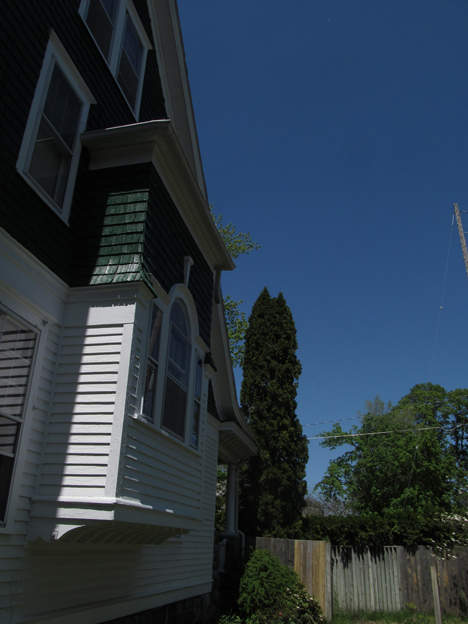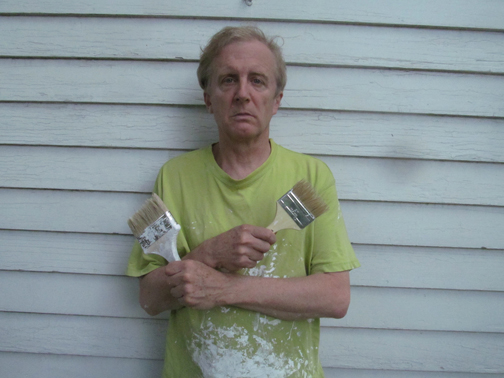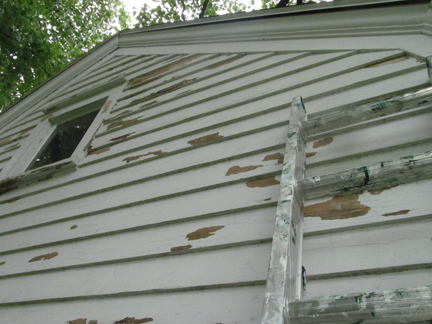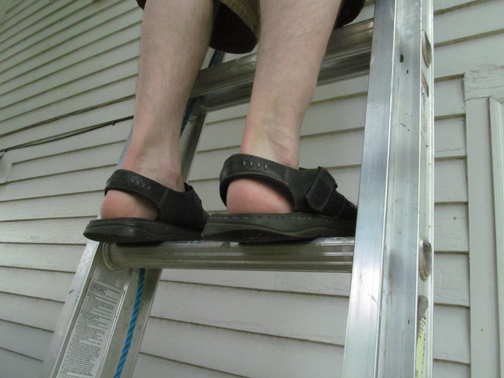David Stairs

I recently came to the end of a three-year creativity cycle. This usually means it’s time to relax, reflect, and reconsider my options. For me, a great way to do a little lateral thinking is my annual painting chore.
I live in a 120 year-old wood frame house built by Mt. Pleasant’s pioneer doctor, Peter E. Richmond. Doctor Richmond died in 1910, and his widow sold the place five years later. When I came to it as fourth owner, in 2003, it was sorely in need of paint.

Wood frame Victorians are vertically oriented
In 2004 I bought a 32′ ladder and began the arduous task of repainting a three-storey house. I’ve been painting houses since I was fourteen, so this was not an unfamiliar activity for me. I’d just never before attempted a building of this size.
After that first full painting, I lapsed into a regular schedule of maintenance painting. Like my Father, I planned to touch up one side each year, with a fifth year reserved for the garage. Michigan has rather unforgiving weather. Today, for instance, it rained hard and hailed, as it often does this time of year. Winters are also unspeakably cold, and this is hard on a wooden house.
This is the reason most of my neighbor’s houses are vinyl-sided. But, as Judith Helfand so humorously conveys in Blue Vinyl, not only is vinyl unrecyclable, it’s totally toxic to manufacture. And it’s not the sort of thing one does to a house built in 1895, thirty-one years before Walter Semon received his patent for plasticizing polyvinyl halide products.

Have brushes • Will paint
When painting a wooden house, the surface must be thoroughly prepared. This entails scraping or sanding loose paint and washing to remove dust from the surface. Then one must prime coat the exposed surfaces. Some people use compressors to apply paint, but then too, some people listen to loud country western music while painting. I do neither. I’ve always chosen to apply paint with a brush, preferably a horse-hair brush, and to hum my own tunes from my internal playlist.

Removing loose, checked, or blistered paint
It’s not optimal to paint in direct sunlight, so I always begin my day on the west or north side and move to the east side in the afternoon. There’s a good deal of moving around when painting, repositioning ladders, picking up paint chips, and clambering up and down, which is really good exercise. I don’t have fear of heights, but I respect them, probably the reason I’ve never fallen. Often nature intrudes. This year I had to trap a muskrat that had hibernated under my garage before I could begin work, and today I was interrupted when my dog uncovered a litter of baby rabbits, forcing me to move them to a more secure hiding place.

In a challenging environment, it pays to use quality paint
One of the things that happens during my summer painting hiatus is I reconnect to the rhythms of the neighborhood. I usually learn the summer-substitute-mailman’s routine, so I can keep the dog inside during his rounds; she hates anybody in a uniform. And I observe all the comings and goings of my neighbors, the utility workers, trash haulers, lawn mowers, and delivery people.

After a couple hours even flattened ladder rungs become tiring to stand on
All in all, if you don’t mind being fifteen feet off the ground house painting seems a pretty healthy activity, aside from standing on ladder rungs. The weather’s been magnificent, clear blue skies and not too hot. I’m able to do a lot of thinking, I get good and tired working, and I take pride in the outcome. On hot afternoons I also treat myself to a 12-ounce Mexican Coca Cola, which comes in a refillable bottle, and is available at the neighborhood party store two blocks away.

Summer reflections
In 1967 Gene Melvin, the long-haul truck driver who lived across the street when I was a child, told my Dad that his was the “best-looking house on the block.” These days, after I get cleaned up from a days’ work, I lay down on my porch swing and enjoy the idea that, like my Father before me, I live in the best-looking house on the block. Not bad for an amateur.
David Stairs is the founding editor of Design-Altruism-Project











Leave a Reply
You must be logged in to post a comment.